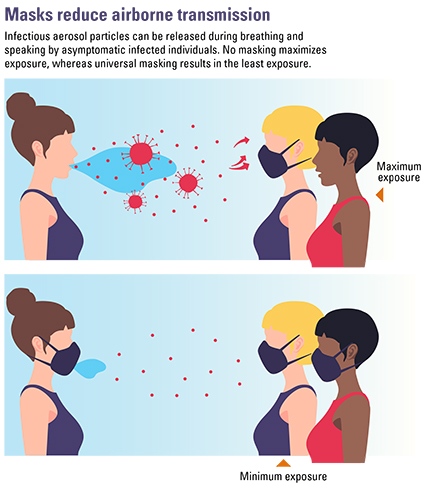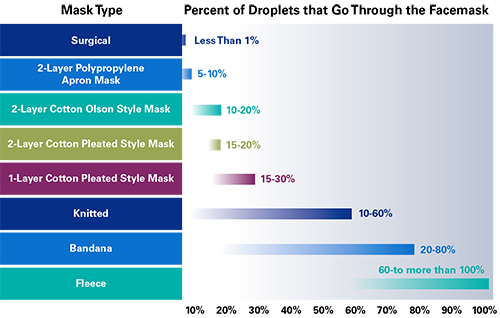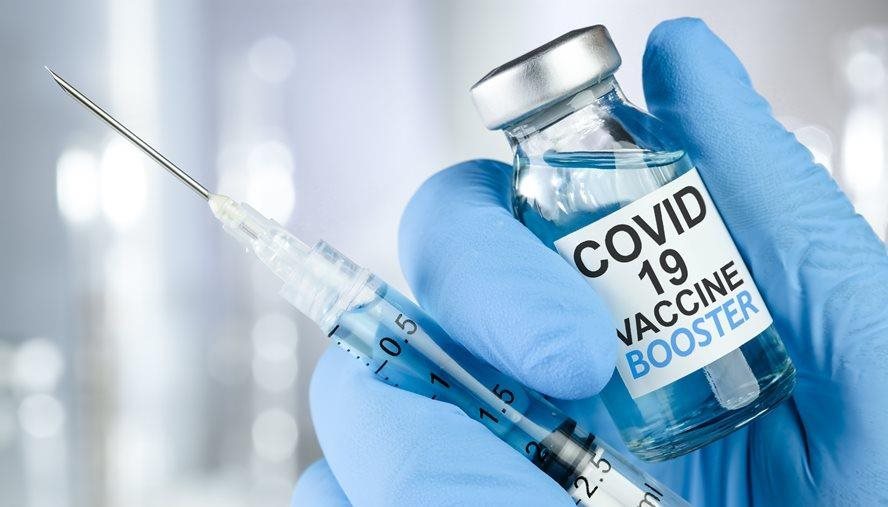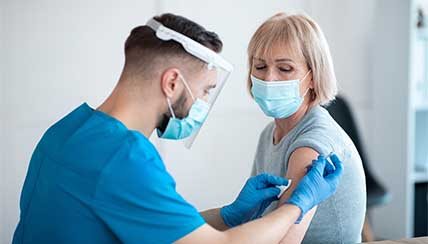How Do Facemasks Work?
This information has been reviewed and approved by Lisa Maier, MD and Rosine Angbanzan, MPH (February 2022)
The coronavirus or SARS-CoV-2 is a respiratory virus. It can be spread when infected and asymptomatic people exhale during breathing, speaking, singing, coughing and sneezing. In addition to inhaling SARS-CoV-2 virus particles, people can be infected by touching contaminated surfaces. Wearing facemasks and washing hands protect you from the virus.
How Does Your Breath Spread Virus Particles?
 Your breath is made up of oxygen, carbon dioxide, nitrogen and water vapor. Anytime a breath leaves your mouth, the gases in your breath cool and turn into liquid. Depending on the size, this liquid is also called water droplets or aerosol particles. Water droplets are larger. Gravity pulls them down to surfaces faster than they can evaporate. Smaller droplets and aerosol particles evaporate quickly, but they can travel with air currents for a period of time. A normal cough can spread particles more than 27 inches. Source
Your breath is made up of oxygen, carbon dioxide, nitrogen and water vapor. Anytime a breath leaves your mouth, the gases in your breath cool and turn into liquid. Depending on the size, this liquid is also called water droplets or aerosol particles. Water droplets are larger. Gravity pulls them down to surfaces faster than they can evaporate. Smaller droplets and aerosol particles evaporate quickly, but they can travel with air currents for a period of time. A normal cough can spread particles more than 27 inches. Source
Asymptomatic carriers are people who have the virus in their airways and do not have symptoms of illness, yet can still transmit the virus. There are an unknown number of people who are asymptomatic carriers of COVID-19. Wearing a mask dramatically reduces how far the amount of exhaled droplets and particles travel and the amount of particles exhaled into in the air from asymptomatic carriers.
Wearing a mask also decreases the chance of exposure when there are virus-containing particles in the air.
Wearing a mask in all public places can significantly reduce your risk of spreading and contracting the disease. This protects you as well as those around you, and the people with whom you live.
Not wearing a mask puts people at the highest risk of catching an infection. No mask means no protection.
How Masks Prevent the Spread of COVID-19
Well-fitting masks have been shown to reduce the size and amount of water droplets or infectious particles released into the air. They can also decrease the speed and distance of water droplets during coughing, limiting the spread of infectious particles when worn properly. To learn which type of mask is right for you, check out our masking guide here.
Researchers have tested a variety of cloth masks and found that when worn properly, cloth masks do prevent COVID-19:
- This study published in the New England Journal of Medicine shows that small to large droplets were nearly all blocked when the mouth was covered by a damp washcloth.
- Research published in Health Affairs that the first five days after a mandate to wear masks dramatically slowed the growth rate of COVID-19.
- Mask wearing lowers death rates from COVID-19 as reported in this study.
- The Canadian Medical Association Journal reported how a man flew from China to Toronto wearing a mask on the flight. After the flight, he tested positive for COVID-19 but because of his mask, the 25 closest people around him tested negative for the disease.
- A study published by the CDC’s Morbidity and Mortality Weekly Report (MMWR) indicated a 70% reduced risk of infection among people using face coverings in close-quarter conditions.
- Another study published in MMWR highlighted the smaller number of cases in U.S. counties with school mask mandates compared to those without.
- This study published in Science Advances, shows that wearing a mask cuts down on expelled droplets during speech, and some materials work better than others.

| The information on our website is medically reviewed and accurate at the time of publication. Due to the changing nature of the COVID-19 pandemic, information may have since changed. CDC.gov and your state’s health department may offer additional guidance. |


